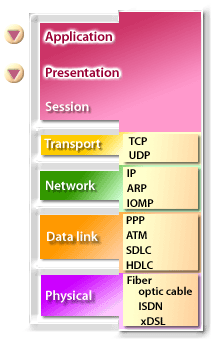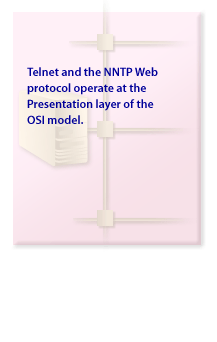| Lesson 8 | Web protocols |
| Objective | Name the protocols used on the Web |
Different Types of Protocols used for the Web
In a Web system, protocols are used to display pages and to fulfill requests for information. You may already be familiar with the most common protocols used on the Web.
Gopher Protocol
The gopher protocol is a utility that searches the Internet for data and news and presents the results in a hierarchy-based document-retrieval system. It's a precursor to the internet and has made research findings more user friendly. Gopher provides a text interface.
Currently the Gopher protocol is still in use on the internet, but its presence is much smaller than it once was.
Here's a summary of its current status:
How to Access Gopherspace:
Currently the Gopher protocol is still in use on the internet, but its presence is much smaller than it once was.
Here's a summary of its current status:
- Mainstream Use: Gopher has largely been supplanted by the World Wide Web (WWW) and its HTTP protocol. Modern web browsers no longer directly support Gopher, and most internet users don't interact with it regularly.
- Enthusiast Community: A dedicated community of Gopher enthusiasts keeps the protocol alive. They maintain servers, develop clients, and advocate for its continued use.
- Reasons for Persistence:
- Simplicity: Gopher's plain text format and menu-based structure offer advantages in terms of speed, efficiency, and accessibility.
- Resilience: Gopher servers can run on low-power devices and handle high traffic loads, making them potentially more resistant to outages or censorship.
- Nostalgia: Some users appreciate Gopher's retro aesthetic and its focus on content over presentation.
How to Access Gopherspace:
- Standalone Clients: Dedicated Gopher clients like Overbite Firefox extension, Burrow Chrome extension, or Lynx text-based browser can be used.
- HTTP Proxies: Websites like gopher.floodgap.com act as bridges, allowing access to Gopher content through a web browser.
- While Gopher is unlikely to regain its former prominence, it remains a viable and intriguing alternative to the mainstream web, offering a glimpse into a different era of internet history and a unique online experience.
HTTP Protocol
HyperText Transfer Protocol (HTTP) is used by the World Wide Web.
HTTP stands for Hypertext Transfer Protocol and is a stateless, application-layer protocol for communicating between distributed systems as the foundation of the modern web. HTTP defines how messages are formatted and transmitted and which actions web servers and browsers should take in response to various commands. For example, when a user enters a URL into a browser and presses Enter, it is HTTP, not the browser, that instructs the ISP's server to fetch and transmit the requested Web page. HTTP works in conjunction with HTML to display web pages. The Hyper Text Markup Language (HTML) instructs the browser how elements of the received web page are to be displayed. HTTP is called a stateless protocol, which means that each command is run without reference to prior commands. Stateless commands greatly inhibit the ability to add behavior
to the language because each command cannot receive or share data with other commands, as occurs in programming languages.
For this reason, many add-in languages have been designed to supplement HTTP to enable interaction with the user such as
The latest version of HTTP is HTTP 3. One of the main features of HTTP 1.1 is that it supports persistent connections. This permits a browser to connect to a Web server receive multiple files simultaneously through a single connection. This version has been available for several years and improves performance by as much as 20 percent.
To better understand the components of the HTTP Protocol, review specific pieces of HTTP, namely caching, connection handling and authentication. It is best to consult the RFC (RFC 2616) for in-depth coverage. HTTP allows for communication between a variety of hosts and clients, and supports a mixture of network configurations. To make this possible, it assumes very little about a particular system, and does not keep state between different message exchanges. This makes HTTP a stateless protocol. The communication usually takes place over TCP/IP, but any reliable transport can be used. The default port for TCP/IP is 80, but other ports can also be used.
- ActiveX, (Deprecated)
- Java,
- JavaScript, and
- cookies.
The latest version of HTTP is HTTP 3. One of the main features of HTTP 1.1 is that it supports persistent connections. This permits a browser to connect to a Web server receive multiple files simultaneously through a single connection. This version has been available for several years and improves performance by as much as 20 percent.
To better understand the components of the HTTP Protocol, review specific pieces of HTTP, namely caching, connection handling and authentication. It is best to consult the RFC (RFC 2616) for in-depth coverage. HTTP allows for communication between a variety of hosts and clients, and supports a mixture of network configurations. To make this possible, it assumes very little about a particular system, and does not keep state between different message exchanges. This makes HTTP a stateless protocol. The communication usually takes place over TCP/IP, but any reliable transport can be used. The default port for TCP/IP is 80, but other ports can also be used.
Latest version of the HTTP Protocol
HTTP/3 is the current latest version, released in 2015 and standardized in 2018.
Here's a brief overview of the evolution of HTTP protocols:
Current adoption:
Overall, HTTP/3 is the most advanced version of the HTTP protocol, offering significant performance and reliability benefits. However, HTTP/2 is still widely used and remains a solid choice for many web applications.
- HTTP/1.0 (1996): The initial version, laid the foundation for web communication.
- HTTP/1.1 (1997): Introduced key features like persistent connections, caching, and chunked transfer encoding.
- HTTP/2 (2015): Brought significant performance improvements with:
- Multiplexing: Allowing multiple requests and responses to be sent over a single TCP connection.
- Header compression: Reducing overhead and speeding up transfers.
- Server push: Enabling servers to proactively send resources they anticipate the client will need.
- HTTP/3 (2018): Further enhances performance and reliability by:
- Using the QUIC transport protocol instead of TCP.
- Offering faster connection setup and reduced latency.
- Improving congestion control and packet loss recovery.
Current adoption:
- HTTP/2: Widely adopted by most major browsers and servers.
- HTTP/3: Still relatively new, but adoption is growing rapidly.
Overall, HTTP/3 is the most advanced version of the HTTP protocol, offering significant performance and reliability benefits. However, HTTP/2 is still widely used and remains a solid choice for many web applications.
(NTTP) Network News Transfer Protocol
If you have ever used a newsgroup, then you will appreciate the importance of NNTP. It allows your emails to discussion groups to be routed and received. News servers use Network News Transfer Protocol (NTTP) to send and receive Internet news (called Usenet news).
Currently, the Network News Transfer Protocol (NNTP) is still used on the internet, but its usage has drastically declined compared to its heyday. Here's a breakdown:
Past Prominence:
Decline and Niche Use:
Current State:
In summary, the NNTP is a relic of the early internet that has been largely surpassed by newer technologies. However, it still serves a niche purpose for specific communities and offers a unique glimpse into the history of online communication.
Past Prominence:
- NNTP was the primary protocol for accessing Usenet, a decentralized online discussion forum system that predates the World Wide Web.
- In the 1980s and 1990s, Usenet was a vibrant and essential source of information and community for many internet users.
- Users accessed Usenet through dedicated newsreader software like Pan and Forte, which communicated with NNTP servers to download and post messages.
Decline and Niche Use:
- The rise of the web and more user-friendly online forums like Reddit and Stack Overflow led to a significant decline in Usenet usage.
- Today, NNTP is primarily used by niche communities and for specific purposes, such as:
- Archiving Usenet discussions: Many organizations and individuals archive historical Usenet content for research and historical purposes.
- Technical discussions: Some technical communities, such as those focused on specific software or hardware, still use Usenet for in-depth discussions.
- Alternative news: Some alternative news sources and independent journalists use Usenet to distribute their content, bypassing mainstream media channels.
Current State:
- While NNTP is not dead, its active user base is much smaller than it once was.
- Finding active Usenet newsgroups can be challenging, and many NNTP servers are outdated or poorly maintained.
- Security concerns exist with NNTP, as its plain-text nature makes it vulnerable to eavesdropping and manipulation.
In summary, the NNTP is a relic of the early internet that has been largely surpassed by newer technologies. However, it still serves a niche purpose for specific communities and offers a unique glimpse into the history of online communication.
Telnet
Telnet is a "terminal emulator for the Internet". Its original use was to permit "dumb" terminals to connect to distant mainframes over the Internet (via a telephone connection). Based on TCP/IP, Telnet now permits a PC to connect to a server and emulate a control terminal (the screen and keyboard used to control the server). Once connected, the user can send commands directly to the server (called the host) and control it through the PC's console (an old name for the keyboard). Because Telnet is used to access mainframes or server, a login ID is required (username and password). Telnet is also a common way for network administrators to remotely control Web servers (also called host servers).
- FTP: File Transfer Protocol (FTP) is the primary protocol used to transfer files and resources on the Internet. The protocol is designed to display files available for downloading or uploading and facilitate login functions. Unlike a common file management utility available on all PCs, the FTP protocol must also address security issues from Internet visitors. This means the ability to process login name and password verification on the server. Once once a user is logged in, the FTP protocol must limit the user's access to only those files or directories for which the user is authorized. Anonymous FTP is when the FTP server automatically logs in all visitors using the same login name and password.

Web Protocols

- Web browsers and servers use TCP/IP protocols to connect to the Internet. Common TCP/IP protocols are:
- Hyper Text Transfer Protocol (HTTP): HTTP takes care of the communication between a web server and a web browser. HTTP is used for sending requests from a web client (a browser) to a web server, returning web content (web pages) from the server back to the client.
- Secure HTTP (HTTPS) : HTTPS takes care of secure communication between a web server and a web browser. HTTPS typically handles credit card transactions and other sensitive data.
- File Transfer Protocol (FTP): FTP takes care of transmission of files between computers.


Internet Protocols - Quiz
Click the Quiz link below to reinforce your understanding of terms and concepts related to Internet protocols.
Internet Protocols - Quiz
Internet Protocols - Quiz